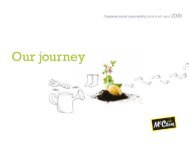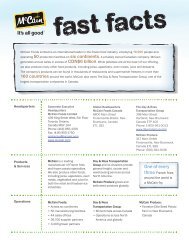From the Ground Up - McCain Foods Limited
From the Ground Up - McCain Foods Limited
From the Ground Up - McCain Foods Limited
You also want an ePaper? Increase the reach of your titles
YUMPU automatically turns print PDFs into web optimized ePapers that Google loves.
TOP: Unloading barrels of<br />
potatoes onto <strong>the</strong> production<br />
line, 1957.<br />
BOTTOm: Packing frozen<br />
french fries into cartons<br />
by hand.<br />
FACING PAGE: In 1959,<br />
<strong>McCain</strong> was producing frozen<br />
potato patties, broccoli, and<br />
peas. The middle photo shows<br />
employees Frank Hickling and<br />
Gene Bulmer receiving an order<br />
of fresh broccoli; <strong>the</strong> truck bears<br />
<strong>the</strong> old <strong>McCain</strong> Produce logo.<br />
Flying doors were just part of <strong>the</strong> local colour at <strong>the</strong><br />
<strong>McCain</strong> <strong>Foods</strong> factory. Ano<strong>the</strong>r feature were <strong>the</strong> hunters<br />
and fishermen tramping through <strong>the</strong> factory with <strong>the</strong>ir<br />
trophies to be stored in <strong>the</strong> public lockers <strong>the</strong> <strong>McCain</strong>s<br />
had included in <strong>the</strong> cold storage area in order to qualify<br />
for <strong>the</strong> federal grant. But <strong>the</strong>se were <strong>the</strong> least of <strong>the</strong> problems.<br />
The bro<strong>the</strong>rs quickly realized that John Baxter, who<br />
had cautioned against basing a potato-processing business<br />
in New Brunswick, was right. “Our first products were<br />
greasy, black fries,” Wallace says. “If <strong>the</strong>re was such a thing<br />
as Grade F, that was what we were producing. We had never<br />
heard of sugar content in potatoes, or ACD [darkening<br />
caused by a chemical reaction in some potatoes after <strong>the</strong>y<br />
have been cooked].”<br />
The problem was simple: <strong>the</strong> local potatoes weren’t<br />
good raw material for french fries. “We should have gone<br />
west … even to Manitoba or Alberta,” Wallace says. “We<br />
didn’t. We thought New Brunswick had <strong>the</strong> best potatoes<br />
in <strong>the</strong> world, but it probably had <strong>the</strong> worst for processing.<br />
The potato growers were growing good seed potatoes, but<br />
<strong>the</strong> poorest you could imagine for processing into frozen<br />
french fries.”<br />
To make good french fries, you need a long potato consisting<br />
of at least 20 percent solids – a potato such as <strong>the</strong><br />
Russet Burbank, a variety prominent in <strong>the</strong> U.S. Pacific Northwest, which produces<br />
a long, crisp french fry. New Brunswick, with its short growing season, didn’t grow<br />
<strong>the</strong> Russet Burbank, a long-season variety. Instead, farmers in <strong>the</strong> Saint John River<br />
Valley and neighbouring Aroostook County in Maine grew round potatoes such as<br />
<strong>the</strong> Kennebec and Katahdin. Easterners found <strong>the</strong>se varieties tastier than <strong>the</strong> Russet<br />
Burbank as table potatoes. But <strong>the</strong>y are far from ideal for french fry processing because<br />
of <strong>the</strong>ir round shape and lower solid content, which result in a short, moist,<br />
or limp french fry. And <strong>the</strong> stony soil of New Brunswick is also less than perfect for<br />
potato growing, since <strong>the</strong> stones can damage <strong>the</strong> potatoes during harvesting.<br />
Not only were <strong>the</strong> potatoes less than ideal, but <strong>the</strong> farmers didn’t know how to<br />
handle <strong>the</strong>m properly. Potatoes produced for <strong>the</strong> fresh table and seed market – <strong>the</strong><br />
only market <strong>the</strong> growers knew – are stored at low temperatures to keep <strong>the</strong>m firm<br />
and prevent sprouting. But at low temperatures <strong>the</strong> potato transforms its<br />
starches into sugar, which caramelizes when <strong>the</strong> potato is fried. This produces<br />
a dark brown french fry. And consumers do not want dark brown<br />
french fries; <strong>the</strong>y want light golden ones. So <strong>the</strong> growers needed to be educated<br />
on how to grow, store, and handle potatoes destined for processing.<br />
In <strong>the</strong> beginning, <strong>McCain</strong> <strong>Foods</strong> had no choice but to do <strong>the</strong> best it<br />
could with what farmers delivered to its plant. In <strong>the</strong> early 1960s, over<br />
farmers’ protests, it introduced <strong>the</strong> Russet Burbank to New Brunswick. But<br />
because of <strong>the</strong> shorter growing season, <strong>the</strong> potatoes were smaller than <strong>the</strong><br />
ones grown in Idaho.<br />
Happily for <strong>McCain</strong>, Donald Young, a plant biologist and specialist<br />
in potato variety breeding at <strong>the</strong> Agriculture Canada Research Centre in<br />
Fredericton, was trying to develop a processing potato better suited for<br />
<strong>the</strong> short eastern Canadian growing season. In 1983, he succeeded. The<br />
new potato, called <strong>the</strong> Shepody, was a boon for <strong>McCain</strong> and has since become<br />
one of <strong>the</strong> three most grown varieties in North America. Because of<br />
<strong>McCain</strong>’s efforts, <strong>the</strong> Shepody is now grown around <strong>the</strong> world.<br />
“Don made an enormous contribution to <strong>McCain</strong> <strong>Foods</strong>,” says Wallace,<br />
“first through <strong>the</strong> Shepody variety, and later in a number of projects, from<br />
teaching and guiding our global team of agronomists for many years,<br />
to greatly improving yields in Manitoba and research in areas where we<br />
planned to build.”<br />
Since its first french fries weren’t top quality, it was just as well that<br />
<strong>McCain</strong>, in its early period, was well diversified into o<strong>the</strong>r vegetables.<br />
For a while, frozen peas were a big part of <strong>the</strong> business, along with french<br />
fries. <strong>McCain</strong> also packed strawberries, broccoli, cauliflower, beans, and<br />
Brussels sprouts. Later, however, <strong>the</strong> company decided to focus on french<br />
fries and stopped processing vegetables o<strong>the</strong>r than potatoes.<br />
In <strong>the</strong> long run, having to struggle to obtain <strong>the</strong> kind of potatoes it<br />
needed benefited <strong>McCain</strong> by forcing it to acquire expertise in agronomy.<br />
Tony van Leersum, who joined <strong>McCain</strong> in 1978 to head European operations<br />
and later became corporate vice-president for agriculture, believes<br />
this expertise enabled <strong>the</strong> company to operate successfully wherever it<br />
went. Because its major competitors, Simplot and Lamb Weston, enjoyed<br />
an ideal growing environment in <strong>the</strong> U.S. Northwest, <strong>the</strong>y lacked experience<br />
in adapting to less favourable locations. As a result, <strong>the</strong> U.S. french<br />
12 <strong>From</strong> <strong>the</strong> <strong>Ground</strong> up<br />
t he BeG inninG 13






